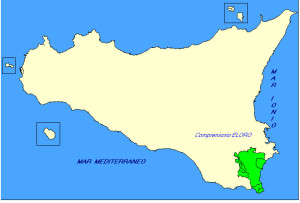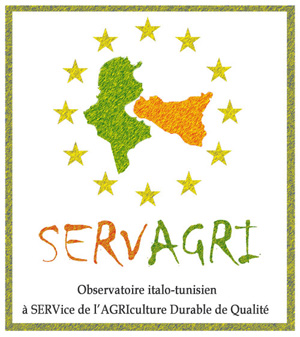The territory
The area which belongs to the Eloro District, pertaining to the Local Development Plan of the LAG Eloro, includes the five municipalities in the south of the province of Syracuse: Avola, Noto, Rosolini, Pachino and Portopalo di Capo Passero, located in the southern end of the Sicilian east coast. The total area is extended for 766.87 kms and constitutes 46% of the entire provincial territory, while the total population of the District represents 43% of the provincial total. It is known that the territory of the Eloro District is characterised by a rich cultural and environmental heritage, with significant archaeological, architectural and naturalistic assets, which give it a strong tourist vocation and a considerable potential for development in this sector. The endogenous resources, which will be extensively presented in this Section, are represented by the areas of environmental importance, such as the natural reserves (i.e. Vendicari, or Cava Grande del Cassibile) or the protected areas (i.e. Isola delle Correnti; etc.), as well as from the large architectural and historical-archaeological heritage that strongly characterises the territory (the Baroque, which made the city of Noto the World Capital of Baroque, but which is also widely present in Avola; the excavations of Eloro, the necropolis scattered in the territory and many others).
Given the extreme richness of this part of Sicily, it goes without saying that, as in many other cases, the number of tourists is considerably under-dimensioned compared to the real potential appeal. There is a renewed interest in sites with significant environmental value, with some attempts to include enhancement initiatives in the district development strategies. (the attractive potential of these sites in particular, is very significant: only for the site of Cava Grande del Cassibile, where the managing body, the Regional State Forests Company, constantly monitors visitors, there are about 35,000 visitors each year, coming from 90 Italian provinces, and over 15 nations (CESIS 2004 data – “Study for the enhancement of Cava Grande del Cassibile”).
The territory is quite vast, there are various environments and landscapes that one encounters while walking through it. They range from a coastal and marine environment which, although sometimes improperly exploited and, in some of its parts, degraded, nevertheless presents a significant attractive force for significant tourist flows; to large inland areas that still have a partially intact territory; to urban environments, various in size, characteristics and historical, cultural and architectural impact; to the rural landscapes of the interior, characterised by the presence of vast highlands dotted with ancient farms.
There are two important rural villages, San Paolo, now almost uninhabited, and Testa dell’Acqua, which is equipped with services of public interest (a pharmacy, the medical guard, an elementary school) and which in summer hosts many vacationers, mainly coming from the territory of Noto. Numerous hamlets scattered throughout the territory, each with elements of significant naturalistic, historical and archaeological interest.
Characteristic elements of the interior landscape are the numerous Paleolithic caves (Cave of Calafarina) and other caves, deep wounds of the limestone plateaus, often of extraordinary landscape and naturalistic value, and with numerous archaeological remains (Cava Grande del Cassibile, Cava Paradiso) , especially referring to the rupestrian architecture belonging to a long period that goes from prehistory to the Byzantine age.
The territory also offers an artistic, anthropological-cultural, architectural, archaeological and oeno-gastronomic heritage of international importance that must be protected, preserved, enhanced and above all promoted and enjoyed in a conscious and sustainable way.
The infrastructures still appear, on the whole, limited and insufficient. As regards the main road network, the inauguration in April 2008 of the highway section between Cassibile and Rosolini, which therefore crosses the district, and the completion of the Syracuse-Catania highway have allowed a significant reduction in travel times, connecting the territory effectively with the main Sicilian cities, while the secondary and service road system and rural roads are weak, as is the railway system. The public transport system, which does not allow adequate connections between the municipalities of the area, between them and the sites of major tourist-cultural and environmental interest, as well as with the capital municipality itself, is very lacking and really worrying as a whole.
As for the existing ports, these do not have the characteristics of commercial ports, being mostly used by local fishermen and boaters, but which are, however, very relevant for a possible tourist enhancement.
Social Description
The resident population in the “ELORO” District amounts to 103,139 inhabitants. It is distributed in five municipalities, of which only the city of Avola slightly exceeds 30,000 inhabitants. Noto, Pachino and Rosolini have a population slightly over 20,000 inhabitants, while Portopalo di Capo Passero, with its 3,873 inhabitants, is the smallest town in the District.
The population density amounts to 134.49 residents. The lowest density is recorded for the Municipality of Noto, in which there are just 43 residents per km2, while all the other Municipalities have a rather high density. This particular situation is a direct consequence of the immense territorial extension of Noto.
Economic Description
The production system of the area is based on an entrepreneurial fabric mainly dimensioned on micro and small enterprises; the weight of trade and wide-ranging professional and entrepreneurial activities emerges, including the real estate, rental, information technology and research sectors, represented by very small production units.
As regards the agricultural sector, we anticipate what appear to be the problems common to the sector, such as the significant difference between the price paid to the producer and that one paid by the final consumer; the difficult relationship with the actors of the large-scale retail trade, to which we are trying to respond with the establishment of the “Val di Noto Quality Fruit and Vegetable District” (DOQVN) which has 102 member companies and is officially recognised by the Sicilian Region and sees the LAG Eloro as the promoter and legal representative. Nowadays it has been recognised its enlargement to the whole Sicilian territory and its consequent transformation into “Quality Fruit and Vegetable Productive District of Sicily ” (DPOQS). Is it also important to mention the poor integration of the agricultural sector with the tourism sector, the lack of product transformation initiative and innovation, limited only to some sectors.
The majority of farms, almost eighty percent of the total, have a size of less than 5 hectares, while fewer than one hundred farms with at least 50 hectares. This is the emblematic fact of the pulverisation of enterprises, which has repercussions in the difficulty of creating efficient production chains in many sectors. In addition, it should be noted that the companies with over 100 hectares are all in the territory of Noto, which has a considerable extension, in some cases the heritage of noble possessions of ancient land ownership.
Main Productions of the District
The most relevant phenomenon appears to be that of greenhouse and open field horticultural production, which takes place mainly in the southern area of the district, around the Municipality of Pachino. In particular, for cultivations in a protected environment (tunnels and greenhouses) we can now say that it is an authentic “agricultural district” of absolute regional importance, which has also deserved ample space in the national press for its characteristics and its ability to market products in international markets. The LEADER Programmes have invested in this sector, especially as regards the implementation of marketing initiatives by producer associations, but also for the training of specialised employees in the management of automated greenhouses, which are now a usual reality in the local scene, and for the achievement of the quality certifications required by the main Community markets. The main productions are the violet artichoke, numerous varieties of potatoes, courgettes, peppers, watermelon and cantaloupe yellow melon. The best known and most valuable product is the cherry tomato, which has obtained the Protected Geographical Indication (PGI) together with the other cultivars classified as “Pachino tomatoes”.
The wine sector appears to be in a phase of profound transformation. Hundreds of hectares of vineyards were removed, especially in the southern area of the area, historically suited to this production, to make profitable greenhouse crops. However, some smart entrepreneurs have taken advantage of regional contributions to provide for the planting of quality vines.
The citrus sector represents one of the most widespread crops along the coast and in the alluvial plains, along the rivers Tellaro, Asinaro and the Gioi stream. The production centre, both in terms of number of businesses and occupied territory, is represented by the municipalities of Avola and Noto.
The main productions are made up of lemons (especially the Syracusan Feminello PGI), mainly around the town of Avola, and oranges (especially the early variety Navellina, Tarocco, Moro, late Valencia).
The LEADER Programmes have allowed some local companies to reach and conquer foreign markets on a permanent basis, focusing on the qualitative characterisation of the product and its organic certification, financing its promo-marketing and participation in international trade fairs.
The fruit sector is composed almost exclusively of almond growing. The main varieties grown are those of Pizzuta d’Avola, Fascionello and Romana.
The almond tree supply chain, despite the fact that this cultivation is among the most widespread in the area, failed to assert itself, although the PGI brand for the Pizzuta d’Avola variety is currently in the way to be recognised. Locally, this product is, at most, from some factories, shelled and subjected to peeling and calibration, but any further processing is carried out outside the area. Recently entrepreneurs from Avola have promoted the establishment of a consortium for the protection of the Pizzuta d’Avola and Fascionello varieties.
The high organoleptic, health and taste properties of the local product and its particular flattened and pointed shape (Pizzuta), which make it unique and inimitable for the production of quality sugared almonds and for the confectionery industry, have allowed it to resist the entry of new competitors in the reference markets, even despite the strong contractions of production due to the frosts.
The presence of so many almond groves in the area, especially on the roadsides, also has a landscape and environmental value, as well as constituting one of the most characteristic emblems of the typical identity heritage and of the indigenous production of the area.
The olive sector in recent years has given the area a lot of satisfaction and prestige. The olive tree is, in fact, also one of the most representative plants of the area, especially that of Noto: it is possible to see large expanses along almost all the state and provincial communication routes that connect the municipalities of the district.
The main cultivated varieties are those Moresca and Tonda Iblea and, to a lesser extent, Biancolilla, Nocellara Etnea and Siracusana. There are few specialised olive groves, while usually this cultivation is in association with almond or carob trees. The particular pedoclimatic conditions allow a very early olive harvest, as early as mid-September, to be completed by October.
There are 8 oil mills in the area, but the olive oil is currently mainly marketed in bulk, although there is no lack of more advanced enterprises that have already received national recognition. Thanks to the commitment of SOAT (Operational Section of Technical Assistance) n ° 31 of Noto, there is the DOP brand “Monti Iblei”, (GUCE L. 322/97 of 25.11.1997) which is favouring the proliferation of small bottling chains; in fact, in the last three years the oils produced in this area have been awarded with Great Mentions and various awards and on several occasions with producers in the Eloro district, one of which was previously supported in marketing and promotional-marketing actions by the LEADER II Programme. In the Eloro District, “Monti Iblei DOP” extra virgin olive oil is produced from both the Tonda Iblea and the Moresca olive varieties.
The cereal sector is essentially based on the cultivation of durum wheat, both in coastal areas and in inland hilly areas. Straw for zoo-technical use is widely diffused.
Animal husbandry is mainly carried out in the hilly areas, usually together with the cultivation of cereals. The bred species are mainly cattle, sheep, and goats. The farming techniques are based on the wide availability of pastures in inland areas, and especially the cattle are left during the day in a semi-wild state. Furthermore, pig breeding is discreet, whose farms are concentrated almost exclusively in the territories of Noto and Rosolini. The sheep and goats are concentrated mainly in the southern area of the territory, finally, the poultry are fairly present with over 160,000 heads, mainly concentrated in the territory of Rosolini. The breeding of horses is weak, mainly raised by amateurs and in some farms in the direction of the tourist market.
It should be noted that all the municipalities of the district are included in the production areas of Sicilian Pecorino cheese (DOP cheese – GUCE L. 148/96 of 21.06.1996), while the territories of the municipalities of Noto and Rosolini are also included in the area of production of Ragusano cheese (DOP cheese – GUCE L. 163/96 of 02.07.1996), produced from the Modicana breed milk.
The fishing sector is headed, mainly, to the fleet of Pachino that, with its approximately 150 boats, is the second largest navy in Sicily for the fresh catch, after that of Mazara del Vallo. The freshly caught product is marketed in the local fish market. Local fishermen complain of the danger of the harbour being silted up, and point out the need for fleet modernisation. There are few innovative initiatives, such as fish tourism. There is also a need for support for the marketing, typifying and promotion of fresh fish.
The farming of fish species, both marine and freshwater, still exist in the area. Of considerable size is the plant located in the municipality of Pachino, which consists of large ground tanks for the breeding of fry (snapper, sea bream, sea bass and other valuable species) and floating cages in the sea for their growth. Some companies, in particular in Marzamemi (Pachino) have started a good fish processing activity time ago, with the production of products linked to the local and Mediterranean tradition (the highly prised bottarga, tunnina, musciame, etc.).

 it
it
 en
en
 fr
fr
 es
es












